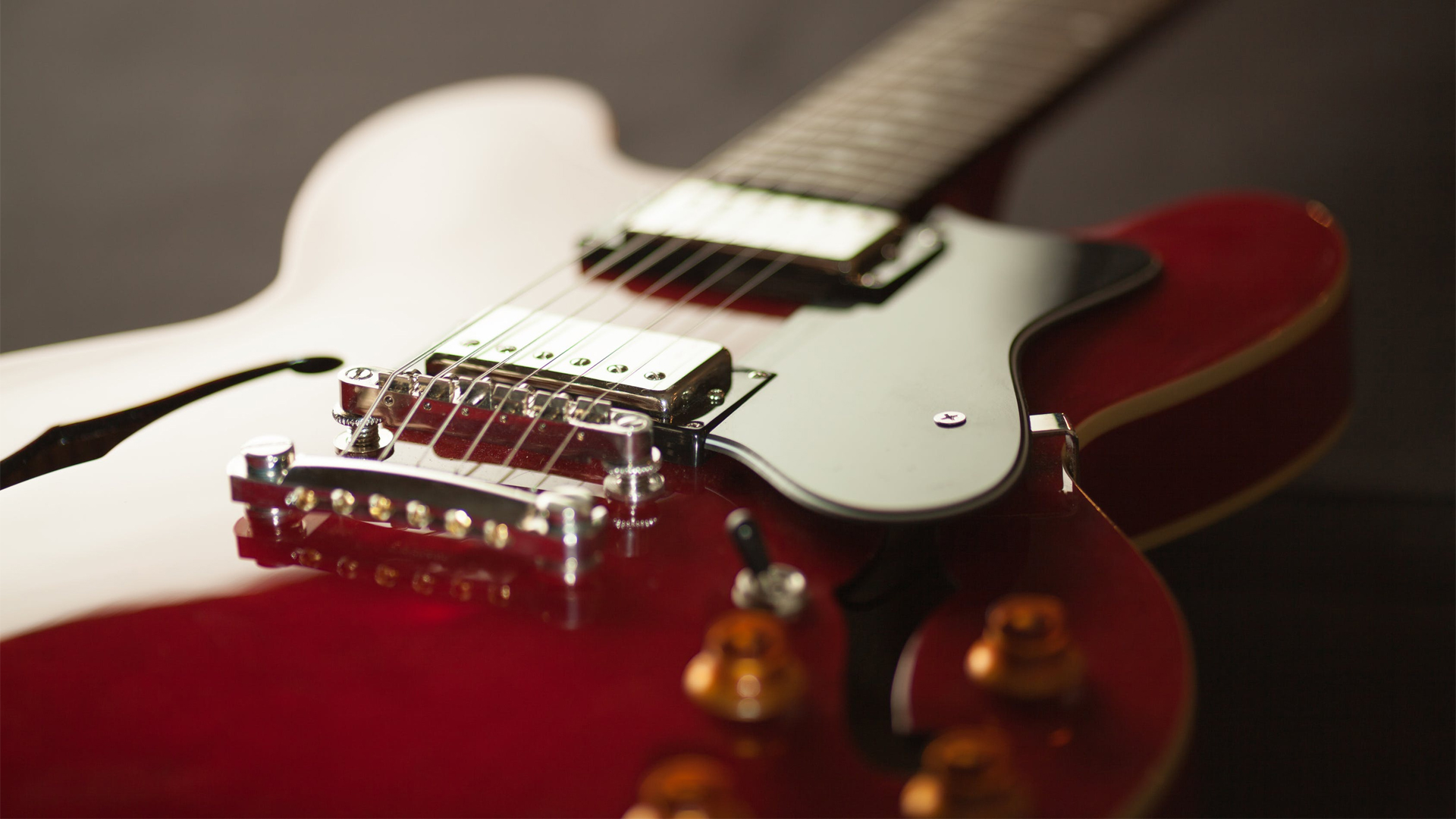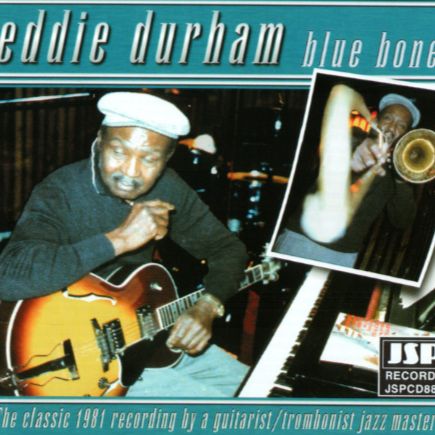Eddie Durham, pionnier du son swing et de la guitare électrique
Guitariste, tromboniste, compositeur et arrangeur, Eddie Durham a joué un rôle fondamental dans la construction du jazz orchestral des années 1930, à la fois comme artisan du swing et comme pionnier de la guitare électrique.
Issu d’une famille de musiciens, Durham commence sa carrière dans des groupes locaux avant de rejoindre les Blue Devils de Walter Page, un creuset du jazz en devenir. Il y développe ses talents d’arrangeur et affine son jeu à la guitare. Après avoir codirigé le Durham Brothers Band et enregistré avec Bennie Moten entre 1929 et 1933, il s’installe à New York où il collabore notamment avec Willie Bryant, puis avec Jimmie Lunceford et Count Basie. Ses arrangements pour des titres comme Swinging the Blues ou John’s Idea participent à l’élaboration du style énergique et raffiné de l’orchestre de Basie.
Eddie Durham s’impose aussi comme un précurseur technique : dès 1935, il expérimente avec des micros fixés sur sa guitare, anticipant l’électrification de l’instrument. Il enregistre avec l’un des premiers modèles amplifiés, mis au point avec Gibson et Rickenbacker, ouvrant ainsi la voie à Charlie Christian et à l’essor de la guitare électrique dans le bebop.
Durant les années 1940, il arrange pour Glenn Miller (In the Mood) et Artie Shaw, tout en dirigeant deux formations exclusivement féminines composées de musiciennes afro-américaines : les International Sweethearts of Rhythm et l’Eddie Durham’s All-Star Girl Orchestra, qui connaissent un vif succès national.
À partir des années 1950, Durham travaille comme arrangeur indépendant avant de rejoindre, au début des années 1980, le Harlem Blues and Jazz Band pour une tournée européenne. Artiste discret mais décisif, Eddie Durham a laissé une empreinte profonde sur l’évolution du jazz orchestral et de la guitare moderne.
Eddie Durham, pionero del sonido swing y de la guitarra eléctrica
Guitarrista, trombonista, compositor y arreglista, Eddie Durham desempeñó un papel fundamental en la construcción del jazz orquestal de los años treinta, tanto como artesano del swing como pionero de la guitarra eléctrica.
Nacido en una familia de músicos, Durham inició su carrera en grupos locales antes de unirse a los Blue Devils de Walter Page, un verdadero semillero del jazz emergente. Allí desarrolló su talento como arreglista y refinó su estilo con la guitarra. Tras codirigir el Durham Brothers Band y grabar con Bennie Moten entre 1929 y 1933, se trasladó a Nueva York, donde colaboró con Willie Bryant, y más tarde con Jimmie Lunceford y Count Basie. Sus arreglos para piezas como Swinging the Blues o John’s Idea contribuyeron a definir el estilo enérgico y sofisticado de la orquesta de Basie.
Eddie Durham también se impuso como innovador técnico: ya en 1935 experimentaba con micrófonos acoplados a su guitarra, anticipando la electrificación del instrumento. Grabó con uno de los primeros modelos amplificados, desarrollado junto a Gibson y Rickenbacker, abriendo así el camino a Charlie Christian y al auge de la guitarra eléctrica en el bebop.
Durante los años cuarenta, trabajó como arreglista para Glenn Miller (In the Mood) y Artie Shaw, al tiempo que dirigía dos orquestas exclusivamente femeninas formadas por músicas afroamericanas: las International Sweethearts of Rhythm y la Eddie Durham’s All-Star Girl Orchestra, que gozaron de notable éxito en todo el país.
A partir de los años cincuenta, Durham trabajó como arreglista independiente, y en la década de 1980 se unió al Harlem Blues and Jazz Band para una gira por Europa. Artista discreto pero decisivo, Eddie Durham dejó una huella profunda en la evolución del jazz orquestal y de la guitarra moderna.
Eddie Durham, pioniere del suono swing e della chitarra elettrica
Chitarrista, trombonista, compositore e arrangiatore, Eddie Durham ha avuto un ruolo fondamentale nello sviluppo del jazz orchestrale degli anni Trenta, sia come artefice dello swing che come pioniere della chitarra elettrica.
Proveniente da una famiglia di musicisti, Durham iniziò la sua carriera in gruppi locali prima di entrare nei Blue Devils di Walter Page, una vera fucina del jazz nascente. In quel contesto affinò le sue capacità di arrangiatore e perfezionò il proprio stile chitarristico. Dopo aver co-diretto il Durham Brothers Band e registrato con Bennie Moten tra il 1929 e il 1933, si trasferì a New York, collaborando con Willie Bryant, e successivamente con Jimmie Lunceford e Count Basie. I suoi arrangiamenti per brani come Swinging the Blues e John’s Idea contribuirono a definire lo stile energico e raffinato dell’orchestra di Basie.
Eddie Durham si distinse anche come innovatore tecnico: già nel 1935 sperimentava con microfoni applicati alla sua chitarra, anticipando così l’elettrificazione dello strumento. Registrò con uno dei primi modelli amplificati, sviluppato con Gibson e Rickenbacker, aprendo la strada a Charlie Christian e alla diffusione della chitarra elettrica nel bebop.
Negli anni Quaranta, curò arrangiamenti per Glenn Miller (In the Mood) e Artie Shaw, dirigendo nel contempo due formazioni esclusivamente femminili composte da musiciste afroamericane: le International Sweethearts of Rhythm e l’Eddie Durham’s All-Star Girl Orchestra, entrambe accolte con grande successo a livello nazionale.
A partire dagli anni Cinquanta lavorò come arrangiatore indipendente, e nei primi anni Ottanta si unì al Harlem Blues and Jazz Band per una tournée europea. Artista riservato ma decisivo, Eddie Durham ha lasciato un’impronta profonda nello sviluppo del jazz orchestrale e della chitarra moderna.
Eddie Durham, a pioneer of swing sound and electric guitar
Guitarist, trombonist, composer, and arranger, Eddie Durham played a pivotal role in shaping 1930s orchestral jazz—both as a craftsman of swing and as a trailblazer in electric guitar innovation.
Born into a family of musicians, Durham began his career in local bands before joining Walter Page’s Blue Devils, a fertile ground for emerging jazz talent. There, he developed his arranging skills and refined his guitar playing. After co-leading the Durham Brothers Band and recording with Bennie Moten between 1929 and 1933, he moved to New York and collaborated with Willie Bryant, then with Jimmie Lunceford and Count Basie. His arrangements for pieces like Swinging the Blues and John’s Idea helped shape the energetic and polished sound of the Basie orchestra.
Eddie Durham also stood out as a technical innovator: as early as 1935, he was experimenting with attaching microphones to his guitar, anticipating the instrument’s electrification. He recorded with one of the earliest amplified guitar models, developed with Gibson and Rickenbacker, paving the way for Charlie Christian and the rise of the electric guitar in bebop.
In the 1940s, Durham arranged for Glenn Miller (In the Mood) and Artie Shaw, while leading two all-female orchestras composed of African American musicians: the International Sweethearts of Rhythm and the Eddie Durham’s All-Star Girl Orchestra, both enjoying national acclaim.
From the 1950s onward, he worked as a freelance arranger and, in the early 1980s, joined the Harlem Blues and Jazz Band for a European tour. A discreet yet influential artist, Eddie Durham left a lasting mark on the evolution of orchestral jazz and modern guitar.


